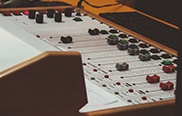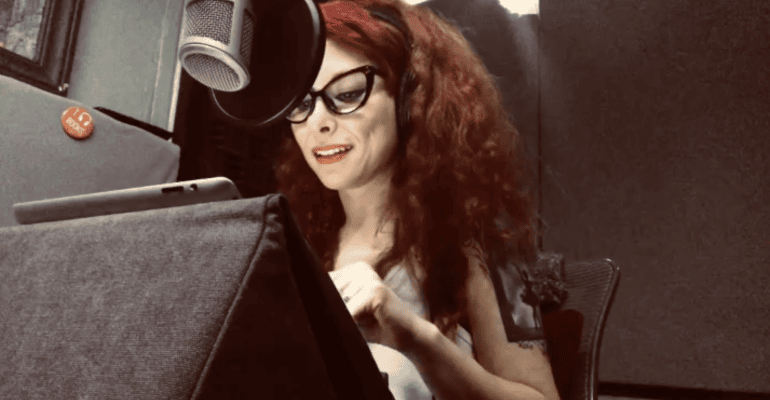It’s handy to have a glossary of voice over terms if you’re a client embarking on your first studio recording with professional voice actors.
Even if you’ve clocked plenty of hours in the sound booth, there are still some terms that can leave you staring blankly at the talkback mic, wondering what on earth everyone’s on about.
Or maybe you’ve been confidently dropping a word that, as the ever-quotable Inigo Montoya in The Princess Bride might say, may not mean what you think it means!
Hey, it happens to the best of us.
After all, it’s not always easy to understand the subtle difference between a pick-up and a punch-in, nor have the full 411 on an ABC if voice acting is not your actual industry.
So, to help marketers and business owners who regularly work with professional voice actors on commercials, promos, and other media, we’ve put together a special voiceover glossary that is sure to make your life a heck of a lot easier.
It covers 30 common terms that many clients often muddle up or misuse.
Using this valuable voiceover glossary will help you sound like a total pro next time you’re in the studio, and, more importantly, ensure your final voiceover sounds every bit as awesome as you imagined.
Voice Over Terms
1. ABC Read
This involves three slightly different interpretations of the same script line or lines.
It is different from a three-in-a-row, which typically means reading a full script three different ways in one take.
2. ADR
ADR is an abbreviation for Automated Dialogue Replacement. It is a process where voice actors replace dialogue, usually in a film or animation.
Originally, the term ADR referred specifically to post-production dialogue recorded to replace the original dialogue in a scene.
However, now it is widely used for all types of dubbing, including previously unrecorded multilingual tracks.
3. Back Bed
This is the instrumental end of a jingle, where you can slot in a voiceover with important information such as an event’s start and end dates, phone numbers, or legal disclaimers.
It’s the opposite of a front bed, where the voiceover comes in at the beginning of a jingle.
4. Rachat
In voiceover contracts, a buyout is a one-time payment for a voiceover.
Buyouts are common in voiceover recordings used organically (meaning, without paid promotion), like IVRs, internal training videos, or even corporate videos uploaded to a client’s website and YouTube channel, but without them being promoted using ads.
A buyout gives the client the right to use the recording indefinitely without any additional fees.
Commercials or any content used with paid ads will typically be limited to the length of the campaign.
5. Clipping
This is a form of distortion that tends to occur when an audio signal is too strong (0dB and above in a digital setup).
When recording, whether in a home or commercial studio, the voice actor or engineer needs to ensure the input signal doesn’t get too close to the clipping level.
6. Cold read
This indicates a first-time read of a script without rehearsal.
Many clients mix this up with a dry read, which actually refers to a more neutral, straightforward delivery.
7. Compression
This is an audio processing effect that evens out volume levels.
Note-to-self: Compression tools have nothing to do with file compression like MP3 or WAV.
8. Cue Up
While the word ‘cue’ is a verb meaning ‘to give a signal’, in the context of a voice recording, you cue up an actor’s voice to match the time and speed of a commercial, or to match the visuals or music in your e-learning or corporate video.
9. Donut
Five hours into recording the same spot, you might be dreaming of a strong coffee and an actual donut!
However, in this case, a “donut” refers to an ad or promo with a changeable middle section.
For example, a jingle might have a break in the middle where advertisers swap in particular messages to target different audiences or highlight different stages of a sales campaign.
10. Double
Recording a double doesn’t mean doing it twice, doing it over, or doing it quickly, as in “on the double.”
It simply means recording a two-person spot or dialogue.
11. EFX
You may wonder what the difference is between EFX and SFX.
Spoiler alert: there isn’t any. They both mean special effects.
12. Flat Fee
When working on a voiceover contract, you’ll likely come across this term.
It’s a one-time fee for the voiceover, so it’s similar to a buyout.
It sometimes gets mistaken for Basic Studio Fee (BSF) or session fee, but these terms are different, in that they’re the compensation the talent receives for studio time.
13. Foley
Foley work involves special sound effects created in post-production and used on radio ads, audiobooks, or other typically non-visual media. Think footsteps, falling rain, and gunfire.
Foley is also often used to cover up sounds that accidentally bleed through during filming,
Foley artists are skilled professionals who recreate and enhance sounds using props on a specialized Foley stage.
They typically work with audio that was poorly captured during filming. Take a look at how they do their work in the video below.
You can also skip to the demonstrations in the video.
14. Hot Mic
A hot mic typically means one of two related things.
The first is that the mic is on and therefore picking up sound.
On the more technical end, it also means that the mic’s input level is high, resulting in a strong signal. Oftentimes, it may be too strong, which can cause distortion or clipping.
15. Level
Getting an audio signal “to level” just means setting it at an appropriate input level for the recording.
To do this, the voice actor reads the lines at the highest volume they’ll use throughout the read.
This then allows the sound engineer to adjust the input level to capture the perfect take.
16. Music Bed
Have you ever listened to an ad or podcast and only realized halfway through or on the second listen that there was a soundtrack behind the voice?
This is the music bed, and not being fully aware of it makes sense.
Fact is, it’s not supposed to distract, but instead it’s there to support the voiceover by adding a particular vibe or feeling.
17. Normalization
Normalizing audio is a process by which the amplitude (or volume) is adjusted up or down so it reaches a target level based on the highest signal level (peak) or perceived loudness (loudness)
You wouldn’t be the only one if you mistook this term for getting rid of background noise.
But that’s a different beast known as noise reduction.
18. One-take
When a voice actor delivers the goods in a single recording, it’s called a one-take.
Sometimes this can be muddled up with the phrase outtake, but this latter term refers to a take that hasn’t been approved and accepted.
19. Pace
Have you been using the words pace and tempo interchangeably?
It’s OK. Many people do.
However, pace indicates the rate at which lines are delivered, while tempo refers to the rhythm of that delivery.
If you’re working on a spot with a specific time limit (e.g., a 15-second radio ad), knowing the pace is crucial.
Lucky for you, Voice Crafters’ free voiceover script calculator, which is based on most major languages, can calculate the pace for you.
20. Pickups
These are re-recordings of specific lines or sections, usually needed because of a slip-up or a last-minute script change.
Not to be confused with re-take, which involves recording the whole script from start to finish.
21. Plosive
When a voiceover is delivered with extra energy, certain consonants (i.e., P, T, K, D, G, and B) can come at you like veritable bullet sounds!
This is called a plosive, though some voice editors just call it a “pop” or “popping”, mimicking the sound that’s been made.
Additionally, most professional voice actors will use a pop filter to tame plosives.
Plosives are different from sibilants, which refer to harsh “S” sounds.
This sound can also be tamed, though, generally by using mic positioning when recording and/or a DeEsser, which is a plugin that’s added to the signal chain to reduce sibilance.
22. Punch In
Sometimes a voice actor will need to record midway through a paragraph or a phrase, so they or their engineer would “punch in” the pickup recording, meaning start the recording at that point. The voice actor could essentially read the entire phrase or line, but the recording would only take place where they are punched in.
23. Read length
This refers to the total runtime of a recording, though sometimes clients confuse it with word count, which, as the term suggests, is the number of words in a given script.
24. Room Tone
Room tone, sometimes called ‘air tone’, is the background noise of the space where a voice is recorded.
It’s not actual silence, but a subtle ambience that works to ensure edits sound smooth and natural.
In this way, it’s not about removing noise but rather it’s what keeps your “quiet” from sounding weirdly empty!
25. Slate
A slate is simply saying your name (and sometimes your role) at the beginning of a take. It’s very common practice for voice artists to slate their names before recording an audition.
It’s particularly helpful to slate when multiple voice actors are working at the same time, as it helps directors keep track of who’s who and which take is which.
Some mix it up with the term ‘tag.’ But this actually refers to a branded line at the end of a spot.
26. Spot
Okay, we’ve mentioned the word “spot” a lot in this voiceover glossary, and it simply refers to a commercial.
Fun fact: the word originated from the days when all commercials were performed live. As these happened in between songs, interviews, or plays on the radio, the commercial performers were seen as being put “on the spot.”
27. STT
Text-to-speech (TTS), also known as voice synthesis, is a type of assistive or AI technology that enables digital text to be converted into audio.
28. Usage Rights
As a client, you might assume that once the recording has happened, you now have unlimited rights to the voiceover.
Nuh uh.
Unless the voice actor has agreed to a one-time buyout fee for the project, you will need to negotiate additional usage fees.
These fees will differ depending on factors such as the length of time the voiceover will be used and where it will be used (i.e., global TV campaign vs. local radio campaign).
29. Walla
This is the murmur of many voices talking at once and is used as background noise for a party, restaurant, or crowded scene.
Apparently, the name came about when actors back in the day had to repeat the word “walla” over and over again to get that background hum.
However, nowadays, with modern sound technology, voice actors can chat naturally among themselves, and the same burbling effect is achieved.
30. Wrap
There’s probably little confusion that “wrap” means “the end”.
But just in case you didn’t know, now you can fully appreciate that moment of pure relief when, after a long recording session, the director finally calls out, “That’s a wrap!”
This voiceover glossary is specially made to help you when working with voice actors during recordings.
However, if you’re at the stage where you haven’t selected the right talent for your project yet, we can help. Voice Crafters offer vetted voiceover artists in 80+ regional languages.
You can simply post your project on our online platform or talk to us to help you with the best casting.






0 Commentaires